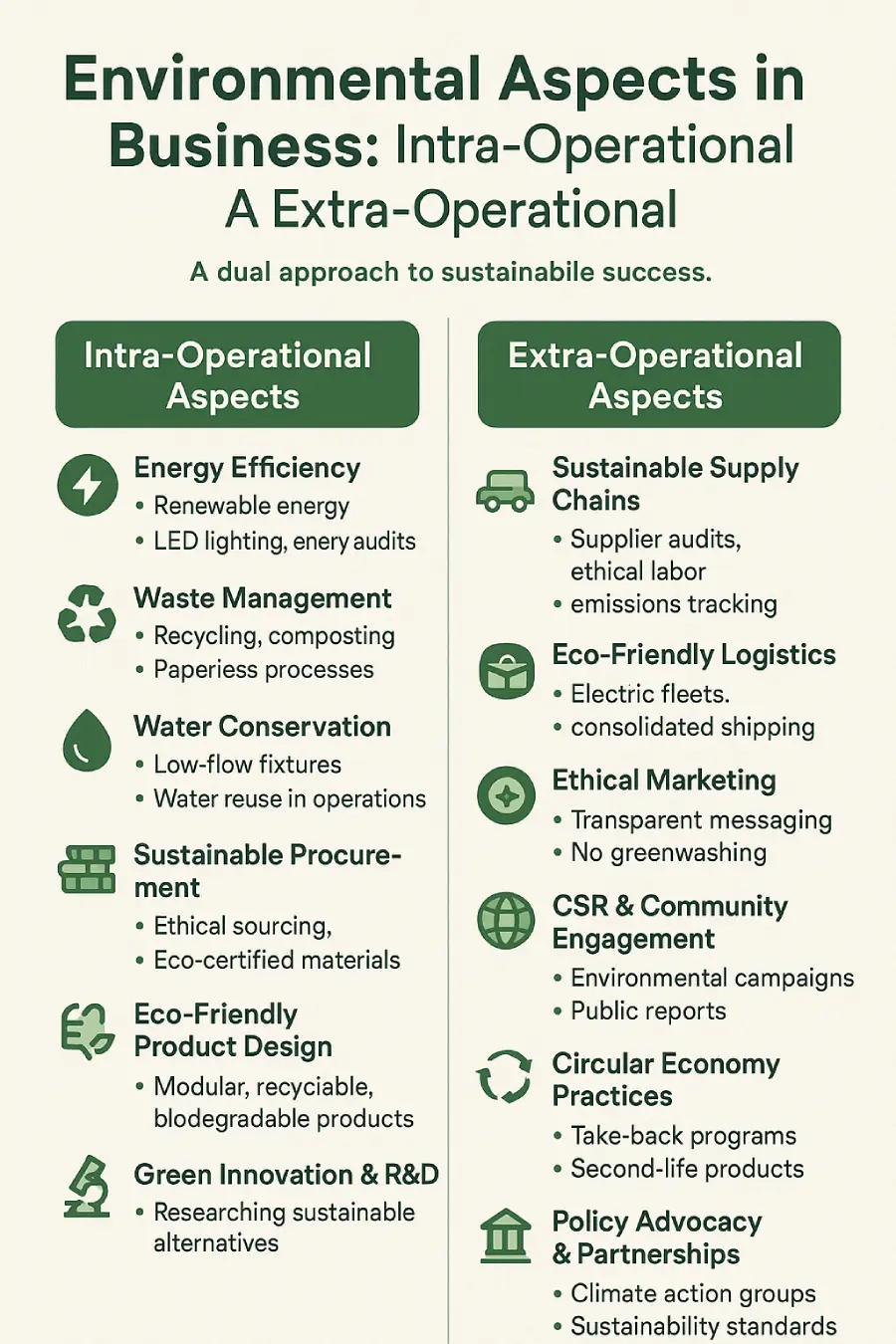🌍 Environmental Aspects in Business: Intra-Operational and Extra-Operational Perspectives
Abstract
Environmental concerns are increasingly central to business strategy and marketing practice. Addressing sustainability not only supports regulatory compliance but also enhances brand reputation and long-term profitability. This article explores environmental responsibility within two key domains: intra-operational (internal processes and operations) and extra-operational (external relationships and societal impact). It outlines how businesses can integrate environmental consciousness into their core functions and external outreach, creating a holistic sustainability strategy.
1. Introduction
Environmental sustainability has become a defining issue for businesses globally, driven by climate change, consumer awareness, and regulatory pressure. Companies are now expected to go beyond profit maximization to demonstrate environmental stewardship.
This responsibility spans both internal business operations (intra-operational) and external business activities and influence (extra-operational). A comprehensive approach ensures that environmental practices are embedded throughout the value chain — from sourcing and production to marketing, logistics, and public relations.
2. Intra-Operational Environmental Aspects
“Intra-operational” refers to all internal processes and resources within the company’s control. These are areas where businesses can directly implement sustainable practices.
2.1. Energy Efficiency
- Objective: Reduce energy consumption in operations.
- Examples:
- Installing energy-efficient lighting and machinery.
- Using renewable energy sources in offices and factories.
- Implementing energy management systems (EMS).
2.2. Waste Management
- Objective: Minimize and recycle operational waste.
- Examples:
- Paperless workflows.
- Sorting recyclable vs. non-recyclable materials.
- Composting organic waste in cafeterias.
2.3. Water Conservation
- Objective: Reduce water usage and prevent pollution.
- Examples:
- Low-flow plumbing.
- Reusing wastewater in industrial cooling systems.
- Monitoring water quality in production.
2.4. Sustainable Procurement
- Objective: Source materials responsibly.
- Examples:
- Buying from local suppliers.
- Prioritizing recyclable, biodegradable, or renewable materials.
- Avoiding conflict minerals or deforestation-related materials.
2.5. Eco-Friendly Product Design
- Objective: Design products that minimize environmental impact throughout their lifecycle.
- Examples:
- Modular design for easier repair.
- Packaging that’s biodegradable or minimal.
- Using recycled materials in product construction.
2.6. Green Innovation and R&D
- Objective: Innovate toward sustainable alternatives.
- Examples:
- Developing plant-based alternatives (e.g., bioplastics).
- Creating low-emission manufacturing techniques.
3. Extra-Operational Environmental Aspects
“Extra-operational” refers to a company’s impact on the broader ecosystem, including external stakeholders, supply chains, marketing practices, and public engagement. It addresses how businesses influence and support sustainability beyond their direct operations.
3.1. Sustainable Supply Chain Management
- Objective: Ensure upstream and downstream partners adhere to environmental standards.
- Examples:
- Supplier audits for emissions and ethical sourcing.
- Encouraging partners to adopt ISO 14001 environmental certifications.
3.2. Eco-Friendly Logistics and Distribution
- Objective: Reduce environmental impact in transportation and delivery.
- Examples:
- Using electric vehicles for delivery.
- Consolidating shipments to reduce trips.
- Partnering with carbon-neutral logistics providers.
3.3. Ethical and Green Marketing
- Objective: Promote products honestly and highlight sustainability without greenwashing.
- Examples:
- Transparent labeling (e.g., carbon footprint, recyclable packaging).
- Avoiding misleading claims about “eco” benefits.
- Campaigns supporting environmental awareness.
3.4. Stakeholder Engagement and CSR
- Objective: Involve communities, customers, and investors in environmental goals.
- Examples:
- Public sustainability reports.
- Hosting environmental education workshops.
- Engaging in tree-planting or conservation projects.
3.5. Circular Economy Initiatives
- Objective: Promote reuse and recycling beyond product use.
- Examples:
- Take-back programs (e.g., electronics recycling).
- Resale and refurbishment marketplaces.
3.6. Policy Advocacy and Partnerships
- Objective: Influence environmental policy and collaborate on sustainability.
- Examples:
- Supporting green legislation.
- Partnering with NGOs for environmental causes.
- Participating in international climate initiatives (e.g., UN Global Compact).
4. Integrated Impact: Why Both Perspectives Matter
Synergy Between Intra and Extra
- Intra-operational practices lay the foundation of a company’s sustainability.
- Extra-operational efforts extend this commitment to society and enhance the company’s public image.
Reputation and Trust
- Companies that align internal actions with external claims avoid greenwashing.
- Authenticity in environmental responsibility builds long-term stakeholder trust.
Regulatory and Market Compliance
- Internal compliance with environmental standards helps meet external regulations.
- Aligns with consumer demand for transparency and sustainability.
5. Measuring Environmental Impact
| Metric | Intra-Operational | Extra-Operational |
|---|---|---|
| Carbon footprint | Factory emissions, energy use | Transportation, partner emissions |
| Water usage | Office/production water consumption | Supplier water practices |
| Waste diverted from landfill | Recycling programs | Packaging take-back initiatives |
| Product lifecycle impact | Material sourcing, design | Post-use disposal or reuse programs |
| Green certifications | ISO 14001, Energy Star | Fairtrade, Rainforest Alliance |
6. Challenges in Environmental Integration
- Cost of Implementation: Initial investment in eco-friendly tech.
- Supply Chain Complexity: Hard to control upstream partners.
- Risk of Greenwashing: Overstating environmental performance.
- Changing Regulations: Need to adapt continuously to local and international laws.
7. Best Practices and Strategic Recommendations
- Conduct environmental audits regularly.
- Set quantifiable sustainability goals (e.g., reduce emissions by 30% by 2030).
- Use life cycle assessment (LCA) in product development.
- Communicate through transparent reporting and avoid vague language (e.g., “eco-friendly” without proof).
- Collaborate across departments — sustainability is not just for the CSR team.
8. Conclusion
Sustainable success in business requires looking both inward and outward. A company’s intra-operational and extra-operational environmental actions should work together in a cohesive sustainability strategy. In doing so, businesses not only fulfill their ethical obligations but also future-proof their operations and appeal to increasingly conscious consumers.
A well-rounded environmental strategy that blends internal efficiency with external engagement is not just good for the planet—it’s good business.

